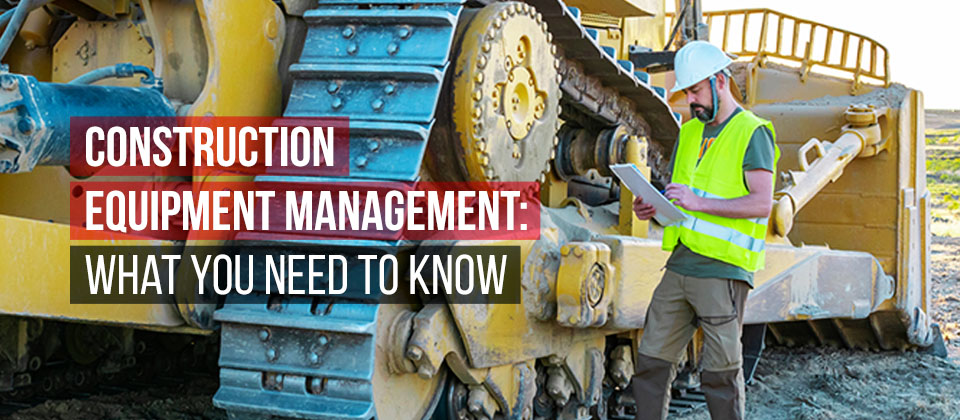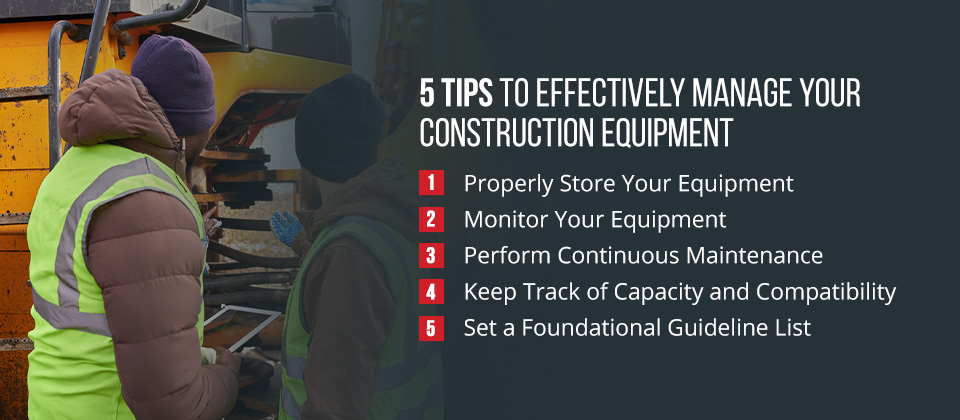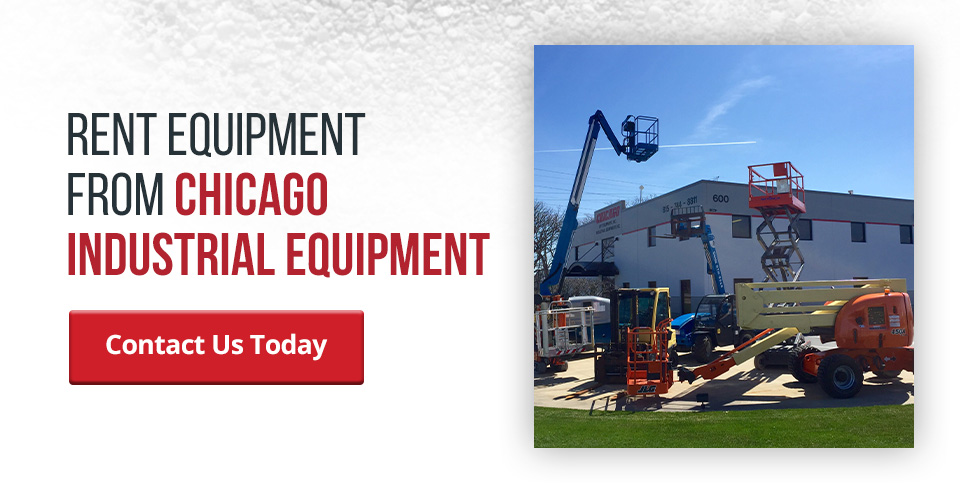Construction Equipment Management: What You Need to Know

Your heavy equipment plays a crucial role in your construction company. Without it, you couldn’t perform the necessary tasks to keep your clients happy. However, construction equipment needs proper management to keep it in the best health so it can continue to serve your business for years to come.
Heavy equipment management can help you reduce expenses, monitor your usage and keep your equipment healthy. With the right strategies, you can get a return on your investment, boost your profits and stay on schedule.
What Is Construction Equipment Management?
Equipment management in construction refers to a business regularly evaluating its equipment and associated costs. Construction equipment management teaches you how to manage construction equipment and is often used to compare projects to the valuation of a fleet. This process allows construction companies to find a balance between their revenue from projects and their equipment expenses.
Construction equipment management is also an effective way for construction companies to evaluate the current condition of their equipment so they can make better decisions, such as when to perform maintenance or upgrade and sell. Effective equipment management strategies will determine the best care for equipment, including how to protect and store it to prevent damage and extend its life span when not in use.
You can evaluate the total costs of owning equipment, including maintenance, storage, repair and transportation costs. A construction equipment manager will help you identify when you’ll break even on your investment and whether your costs are operational or idle expenses that you can reevaluate and reassign. The primary goal of construction equipment management is to increase a company’s return on investment.

5 Tips to Effectively Manage Your Construction Equipment
If you’re new to construction equipment and management or want to build out your existing plans, use the following five tips to more effectively manage your construction equipment.
1. Properly Store Your Equipment
Company equipment management starts with finding ways to store your equipment correctly. Improperly storing your equipment can cause it to break down sooner rather than later, forcing you to make more frequent repairs or invest in brand-new equipment.
Most construction equipment is designed to work in harsh outdoor conditions. Despite their ability to work in these environments, they still need to be stored correctly when not in use to prevent unnecessary damage, such as rusting from moist environments or collateral damage during storms.
If you’re storing your construction equipment outdoors, you can find covers to fit any equipment type. These covers allow you to protect your equipment from the elements, whether storing them for extended periods or between jobs. Construction companies with access to storage facilities can keep their equipment safer since it will be stored indoors, but they’ll need to factor in the costs of a storage facility. Indoor storage may be the best option to protect your investments if you have an extensive fleet, which will go a long way in reducing repair costs.
On top of storing your equipment correctly, you’ll need to store diesel fuel and coolants in the proper locations. You don’t want these fluids to be contaminated by water, dust or other debris since this can cause problems for your equipment and damage crucial components. Storing your fuel and coolants in dry environments isolated from contaminants is one of the best ways to save on repair costs.
2. Monitor Your Equipment
Construction companies must keep their heavy equipment in the best condition possible to complete projects effectively and on schedule. Managing your equipment should always include monitoring your fleet and its condition. Common things to look out for include:
- Dirty or clogged air filters
- Chips or cracks on the windows or windshield
- Low fluid levels
- Worn-out tires
- Cracks or other signs of damage to the body of the equipment
- Poor grease fittings
Regular inspections and equipment monitoring can help you catch these problems early before they become a more severe and costly problem. Assigning a construction equipment manager to perform inspection tasks or keep track of inspections can help you spot problems and immediately make repairs if an operator discovers a problem.
3. Perform Continuous Maintenance
Preventative maintenance will help you keep your fleet in optimal condition for your construction work. You can keep up with maintenance tasks by assigning roles to employees that designate when they should conduct maintenance and what tasks they should be performing. Additionally, operators or staff members should perform daily tasks as part of a comprehensive maintenance plan, such as:
- Checking for visible signs of damage
- Ensuring fluid levels are topped off
- Checking the operation of safety features
- Changing oil or filters
- Inspecting tires
While you’ll generally follow the same maintenance tasks daily, you may want to adjust your tasks if you’re working in a harsh environment. For example, if a construction project is exposed to more dust than other jobs, you can check or change filters more often to prevent clogging.
4. Keep Track of Capacity and Compatibility
Your construction equipment has a specific capacity, meaning it can only handle specific load sizes before the wear on the equipment becomes too great. Your equipment is more likely to become damaged if you try to overload the equipment, delaying your schedule and increasing costs.
As part of your company equipment management, pay attention to your equipment capacity and have the information available to all operators in order to reduce the risk of overloading equipment. You should also track which attachments are compatible with different equipment models in your fleet. Attempting to fit incompatible attachments can cause unnecessary damage, resulting in costly repairs. Your equipment can also run less efficiently or fail, which can cause injuries to operators and other workers.
5. Set a Foundational Guideline List
Creating guidelines or rules for your construction staff regarding your equipment can ensure your employees don’t unknowingly engage in activities or practices that could cause significant equipment damage. Guidelines can also help your operators get the most out of the equipment, which can help boost productivity and reduce the risk of going over scheduled time limits.
You can use your manufacturer’s manual and research from other sources to find ideas for a foundational guideline list. You should look for maintenance schedules, procedures and other information to create a list for your personal fleet. Once you’ve created a list, inform your operators and make the list easily accessible so they can follow these guidelines and procedures to protect your equipment.
Benefits of Construction Equipment Management
While setting up a construction equipment management system takes time and resources, there are many benefits to developing this system for your business. Advantages of using construction equipment management for your fleet include:
- Stronger visibility: An adequately implemented construction equipment management system will make it easier to determine where your equipment is stored, its status and its use in your projects. This information is vital to understanding the health of your equipment, which will inform maintenance, repair and future investment decisions.
- Lower expenses: Construction equipment management allows you to keep track of equipment maintenance and how long your existing equipment will take to complete tasks, allowing you to reduce your project overrun and repair costs.
- Better safety standards: You can keep your fleet up to date with a construction equipment management plan, which is safer for everyone involved in your construction projects.
- Fewer delays: Construction equipment management provides businesses with real-time data at their fingertips, allowing managers to make quick decisions regarding how to use equipment. As a result, managers can boost productivity and reduce the risk of project delays.
Rent Equipment From Chicago Industrial Equipment
If you’re looking for rental construction equipment, Chicago Industrial Equipment has you covered. Our comprehensive inventory includes everything from dirt equipment and telehandlers to industrial forklifts and attachments. We can help you find the right equipment, no matter the job.
We carry numerous brands to give you access to the best choices, all in one convenient place, including Caterpillar, Bobcat, Toyota, John Deere and Nissan. Contact us online or call us today to learn more about our rental equipment.


